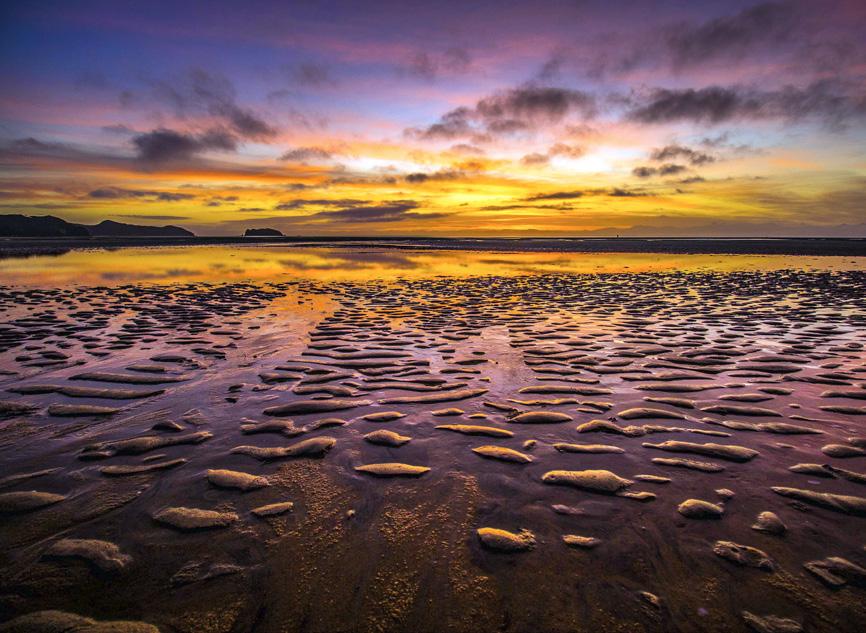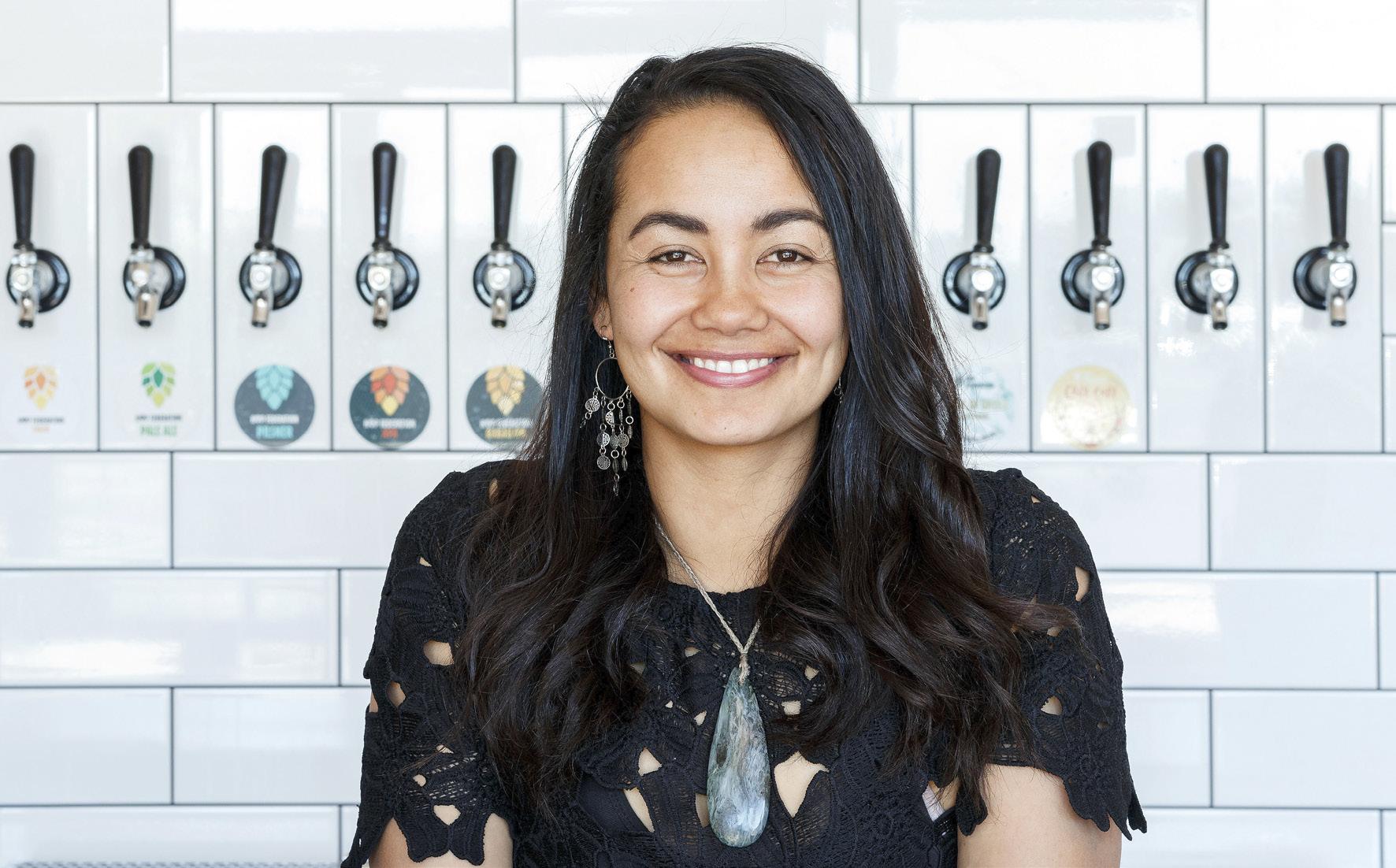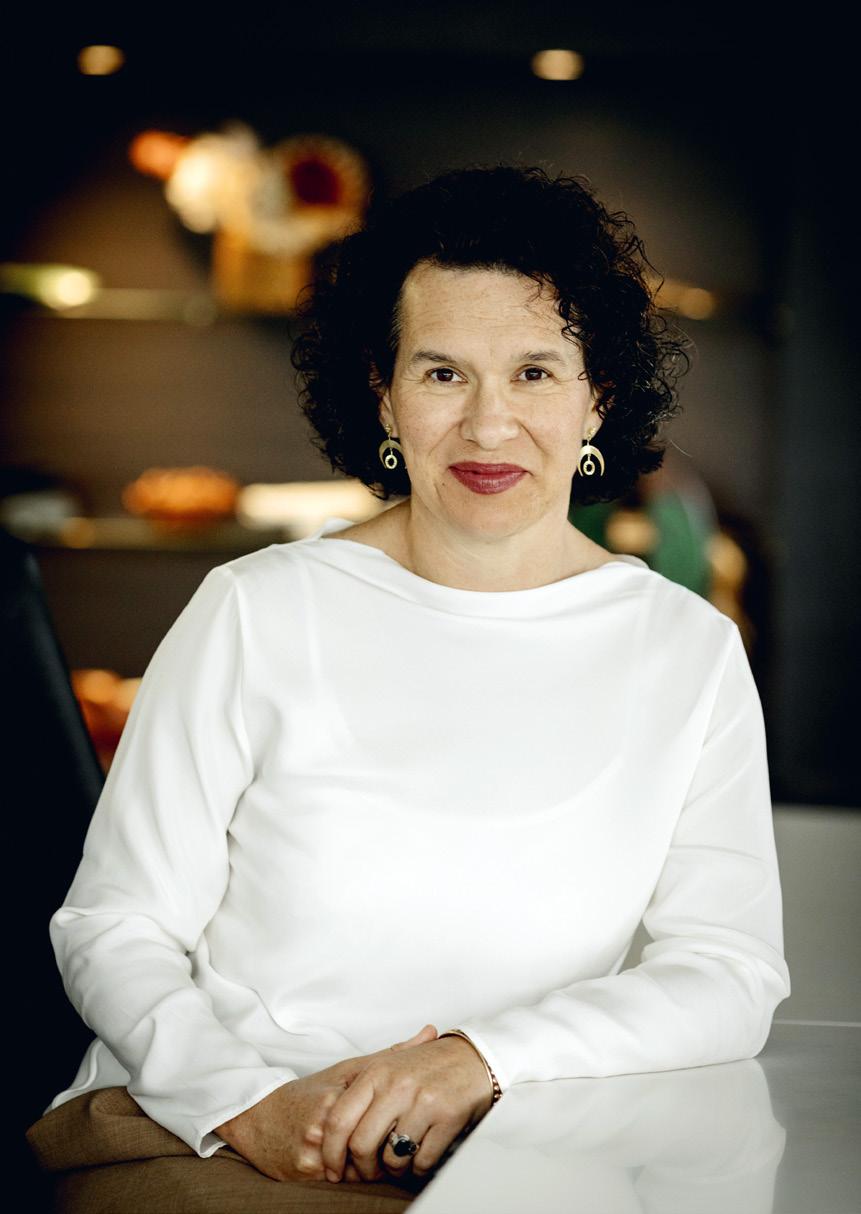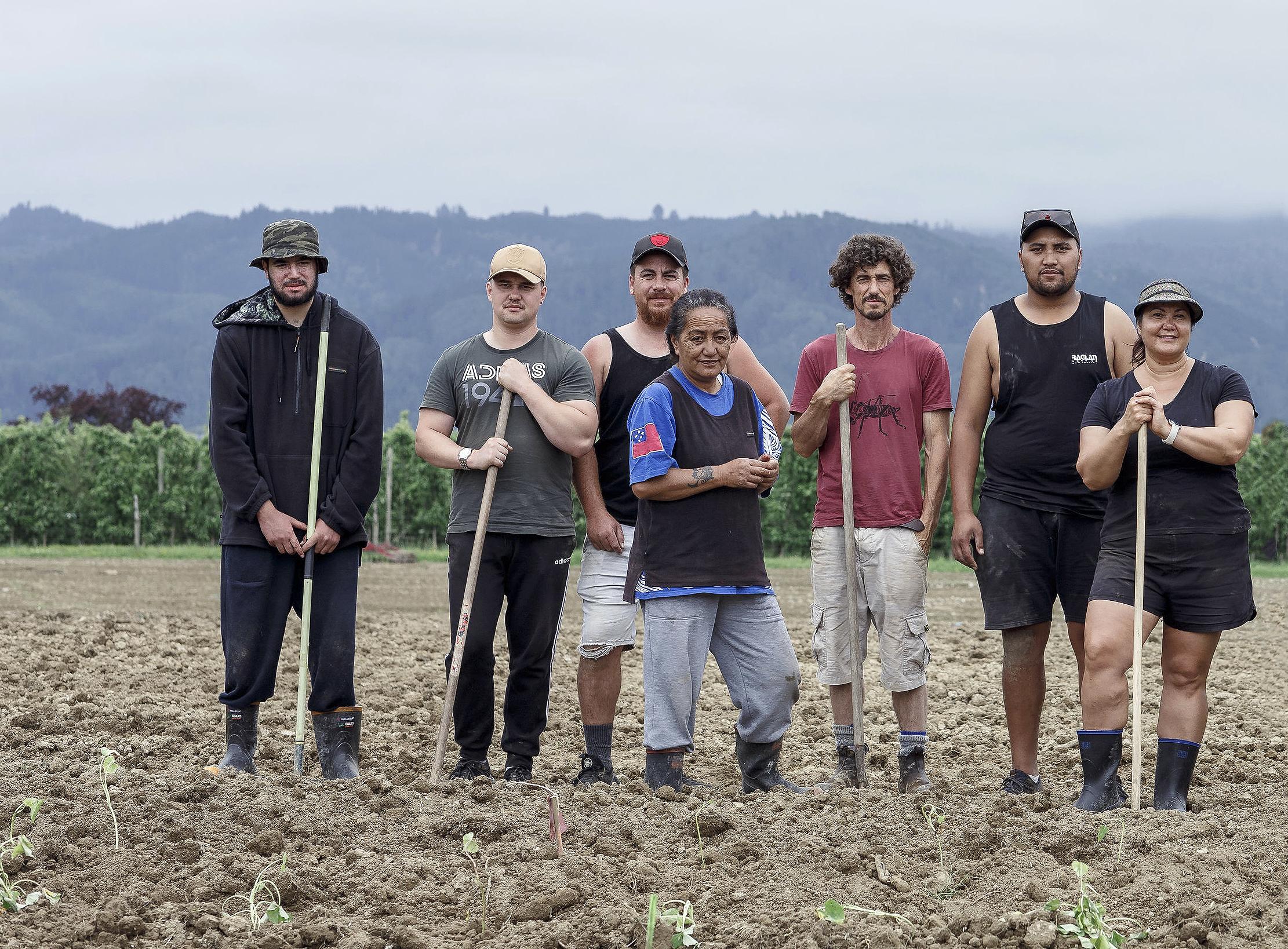
16 minute read
Moko Kauae


ERINA WEHI-BARTON (Ngāti Rārua)
Photo credit: Virginia Woolf
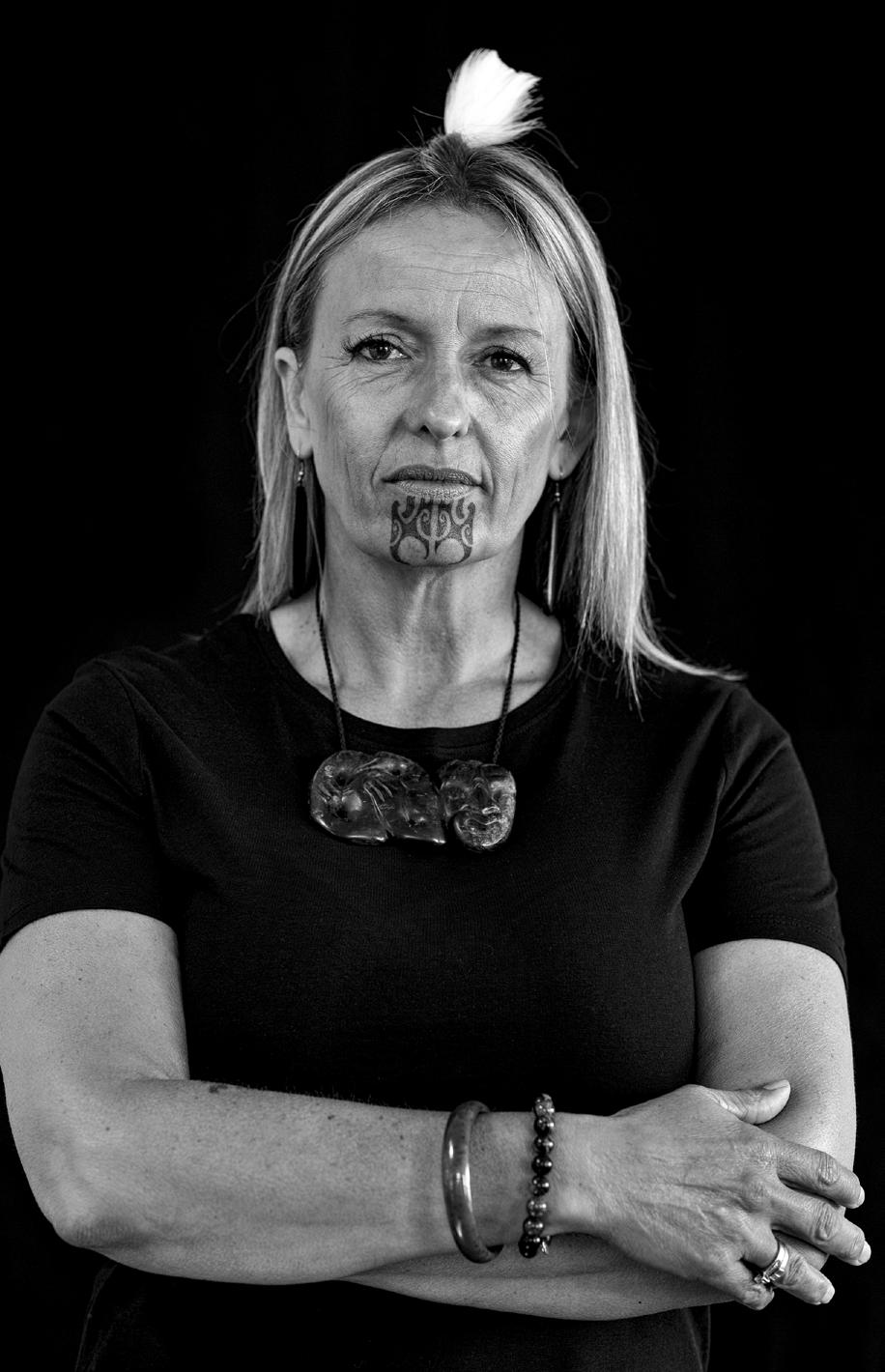
KELLI TE MAIHAROA (Ngāti Rārua, Te Ātiawa)
Photo credit: Virginia Woolf
[1] LEANNE WHITE-HAVERKAMP (Ngāti Koata, Ngāti Rārua, Ngāti Tama ki Taranaki) has a Master’s in Māori and Indigenous Leadership from Te Whare Wānanga o Waitaha, Canterbury University. She was a recipient of a Wakatū scholarship in 2019, a member of the first cohort of Te Rākau Pakiaka, the Wakatū whakapapa wānanga, and completed ahi kaa, the outdoor endurance wānanga, in 2016. Leanne is based in Rotorua.
[3] ERINA WEHI-BARTON (Ngāti Rārua) is passionate about engaging Māori in healthy pursuits. Her first involvement with Wakatū was in 2016 when she was sponsored to run a marathon along the Great Wall of China. Shortly after completing the ahi kaa in 2018, she climbed Sagarmatha (Mount Everest). Erina is part of Karioi, the Wakatū indigenous crops project. She lives in the Maniapoto rohe. [2] BONITA MOANA MISILISI (Ngāti Rārua) is the Auckland South manager for Dress for Success. Based in Auckland, she has had a visible presence in national media as the Māori spokesperson for food allergies in Aotearoa, following the tragic death of her daughter from anaphylaxis in 2018. Bonita regularly attends Wakatū annual general and special meetings, and completed the ahi kaa wānanga in 2018.
[4] KELLI TE MAIHAROA (Ngāti Rārua, Te Ātiawa) holds a Doctor of Philosophy from Te Whare Wānanga o Otāgo, Otāgo University, as well as two tumuaki portfolios at Te Kura Matatini ki Otāgo, Otāgo Polytechnic, where she is the director of Māori Research, with a focus on decolonising methodologies, Māori education, peace and social justice. Kelli is the Kaihautū: Te Kāhui Whetū, and will be leading a Wakatū cohort online to complete a Bachelor of Management in 2021. She is working to develop micro-credentials for Wakatū Owners and kaimahi, and completed ahi kaa wānanga in 2020. Kelli lives in Wānaka.
PHOTOGRAPHY: VIRGINIA WOOLF
Leanne White-Haverkamp, Erina Wehi-Barton, Kelli Te Maiharoa and Bonita Misilisi, all members of Te Hunga Panuku, a network of Owners actively engaged in Wakatū programmes and events, reflect on the re-emergence of moko kauae in Aotearoa and what their own moko kauae means to them, in a discussion with Rōpata Taylor.
Rōpata: Why do you think we’re seeing a revitalisation of moko in the last 10 to 15 years, and why is it being led by Māori women?
Leanne: Women, through the generations, have led movements. Whether it’s within governance, whether it’s on the marae, it is our women who are leading them. Ninety per cent of those doing the Masters of Māori indigenous leadership were wāhine. It doesn’t mean to say that our men aren’t coming; they do follow eventually. Moko kauae for me has been a movement. A movement of resurgence and revitalisation. It’s a renaissance. Kelli: I’ve always been fascinated by kauae and mataora. I didn’t know if it was for me, because coming from Wānaka and Ōtepoti, there’s not a lot of kauae around. It wasn’t until I went to Taranaki that I thought I would like to wear moko kauae. I was coming into my fiftieth year. I had a partner who supported me and there’s a big part of me that wanted to bring it back for our whānau in the south. We haven’t had moko kauae or mataora in our whānau since my tupuna Te Maihāroa in the 1800s. So it’s been invisible. It was almost like a statement that we can regenerate and reinvigorate parts of us from the past and bring it into the future.
I think I’d been waiting until I had gathered a level of reo so that I felt confident in wearing kauae. But a friend said to me, ‘It’s your birthright as a Māori woman to be able to wear your whakapapa.’ It is also for our younger generation so they can be proud to be Māori and to have that visibility around them to strengthen our identity as wāhine Māori.
Erina: Mōku aku nei, ko te wahine te tīmatanga me te whakamutunga o te ora. I think for me, it’s definitely about my responsibility back to my people to ensure the preservation of whakapapa. That’s ā-wairua, ā-tinana. I also think that sometimes it takes one wahine to step forward and say ‘I’m ready’, to empower the rest of our wāhine to say, ‘When we’re ready, we will come.’ It’s a birthright. Ahakoa ngā kōrero o te whānau, koira tōku whakaaro. A wahine knows when she’s ready, and only she knows when she’s ready.
It’s honourable to support many of our whanaunga coming forward. I have no doubt in ten years’ time, we’re going to see the next generation also embracing moko kauae.

LEANNE WHITE-HAVERKAMP
Bonita: For me, I think if it wasn’t for seeing other women with moko kauae, I don’t know if I would have had the courage to go ahead with it. I’ve always had the longing for it, but kept that longing to myself. Now, with the revitalisation of moko kauae, it is more accepted. Not only by society but by seeing it more everywhere. So many women have moko kauae and it’s beautiful to see. That really helped in my decision to go ahead and get one.
Rōpata: Why do you think Māori women have outpaced Māori men in taking a moko kanohi?
Kelli: Māori wāhine as nurturers at home have held onto those strong Māori values. I don’t think that Māori women let go of having moko kauae. If you look historically, it was Māori men that quickly stopped mataora when they were moving out and connecting with Europeans, but the Māori women were still getting moko kauae. So I’m not surprised that Māori women have revived the tradition and carried it forward. And, I think that Māori men are looking around and going, actually, our wāhine have carried these cultural traditions through to contemporary times, and maybe it’s time for us to think about that commitment for ourselves. So we’re seeing a bit more of mataora down south now, also.
Rōpata: What kind of reaction do you get from people?
Bonita: Before I got my moko kauae, I had this perception that I was going to get a lot of flack. People would ask me a million questions, and question me about my worthiness for the moko
kauae. What I find is, I actually get almost an immediate respect from Māori. It makes me slightly uncomfortable because I’m used to earning respect and now it comes automatically, but I still want to earn it.
Leanne: My daughters are more aware of others and how they perceive me. They’re the ones that will say, ‘That one’s looking at you. How dare they.’ They’re more defensive. I don’t know whether it’s because I’m feeling that way and I’m noticing more, maybe I’m more consciously woke. Recently, the alarm went off in my husband’s massive big flash truck. He was away. I went out to investigate, and three people jumped to the conclusion that I was stealing it. Maybe I did get that reaction before I had the kauae, but I wasn’t aware of it.
Kelli: It depends on where I’m going. In Taranaki, people don’t really look twice at wāhine with moko kauae. In Wānaka, I think maybe there’s two of us in the village with moko kauae. I actually had one woman snigger at me at the supermarket in Wānaka, and I just thought, ‘I feel really sorry for you that you’re that out of touch that you can’t accept Māori traditions are indigenous of this whenua.’ I recently did a trip up north, and people were looking at me going, ‘What’s that Pākehā girl doing wearing it?’ You could see them kind of looking at me because I’m fair and have European features. One young boy asked me, ‘How come you’re allowed to wear a moko kauae being Pākehā?’ I said, ‘I’m a Te Maihāroa from the South Island’. But there’s not one day since I’ve had my kauae that I haven’t been proud to wear it.
Erina: Back home, for a long time there were no wāhine in the valley that wore moko. When I was little I always knew I was to be a wearer of moko. One day I was ready, and I went and spoke to my mum. She asked, ‘Are you ready for everything that might come with it?’ I said, ‘I was born ready.’ In the process of it, our whānau said, ‘We want you to draw blood in our whare tupuna. Kinohaku is the wahine of our waterways back home and wai has always been my thing; waiora and tuna. So, long story short, we had our ceremony in our whare tupuna and I invited those who needed to be there to share space and energy. I always knew that my role was to hold space for when everybody else is ready to come. I was actually the youngest in our iwi at the time to get moko done. But it’s not about how young you are. My kuia always taught me, ‘Your wairua speaks volumes before your tinana.’ So that was part of the journey.
Rōpata: As a Māori, when I see someone with moko kauae, it makes me feel good about my own identity. How do you think you are perceived outside Aotearoa?

BONITA MOANA MISILISI

Kelli: When I was in Singapore and Jakarta, they were almost moving away from me. They weren’t quite sure. But when I went to Peru and Chile, I had a couple of indigenous people come up to me and say, ‘Oh, cool moko.’
Leanne: In my experiences abroad, when I encounter some indigenous peoples, they cry. They cry because they say, ‘We had that. What you’re wearing reminds me of the face of our ancestors.’ I think that was the biggest moment for me when I realised it means something to other indigenous peoples. They recognise it. So, my kauae has really reached beyond Aotearoa in making networks and connections.
Erina: We’ve had hui with Inupiat whānau in Alaska. They’re on a revival phase of their reo. I’ve attended a few reo wānanga in Alaska and also moko wānanga and looked at ways to awhi those wāhine that want to re-enter this realm. I went to Everest, or Sagarmatha, koira te ingoa tūturu. We entered a village and this kuia was there and she started to cry. I wasn’t sure what had happened, but they explained that they’ve lost the art of kauae. She said it was a blessing to actually see it again because it’s been lost for 108 years. Their markings of wāhine were around their maunga.
Rōpata: There are a lot of people who are familiar with seeing kauae, but with others, it makes them feel quite uncomfortable. Why is that?
Leanne: My cousin and I were on the door at the Wakatū annual general meeting welcoming whānau, and we noticed some whānau would deliberately not make eye contact. They’d see us and avoid us. So from this observation, we thought we must appear intimidating. It could be because whānau don’t have te reo and they see us as, ‘They’ve got kauae, they’ve got te reo, don’t speak to us.’
Rōpata: In some ways it could remind some of our whānau of that cultural loss and the whakamā of that loss?
Leanne: Exactly. Definitely the whakamā. That’s a massive tool of paralysis.
Bonita: Having a moko kauae, sometimes there is an assumption that we can all speak te reo fluently. I can’t, but sometimes they’ll just break out in te reo Māori. Total strangers, talking to me and I’m like, ‘Oh, aroha mai, we’re learning together.’ I’ll tap my chin so that they’re aware of it, so then they can start speaking to me in English. I wish that I could speak fluently. I feel whakamā.
Kelli: I get asked even by Māori people, ‘What have you done to deserve it?’ You might be at the supermarket, you might be going to a show, and ‘Oh, you’ve got kauae. What have you done to
KELLI TE MAIHAROA
deserve that?’ Would they say that if I had a rose on my shoulder? For me, I think getting my kauae was also about giving me strength for the next stage of my life. To remind me that I have strength from my tūpuna to support me in the mahi I have ahead of me.
Rōpata: Why do you think tā moko, or kauae, makes some non-Māori uncomfortable?
Leanne: In Rotorua, where I live, just about every wāhine you see is wearing kauae. I was involved in an incident with the media earlier this year in Rotorua where one particular motel owner insisted it was a Work and Income barcode. I think for Pākehā in Rotorua, we weren’t as visibly Māori before, but now, for some, it’s threatening, because there are more of us and we’re not going to hide. Women having kauae, they are also more forceful in their voices being heard. We’re not holding our hands over our mouths anymore. So that’s threatening.
Rōpata: It has been said that moko kauae represents metamorphosis, growth, change and crisis. I was wondering when you knew you were ready to get the moko, and whether this take on moko kauae resonates with you?
Bonita: One hundred per cent. I had to allow myself to do it, to give myself permission. I didn’t need permission from anyone else.
Leanne: Totally. For me it was about the journey of affirming my cultural identity and, more importantly, making my connections in the south and having a sense of belonging. I know where I belong. I know where I feel connected. This is the final step in reclamation for me. But it’s only the beginning of the rest of the journey of my growth. I know I have a big responsibility. Growing my language, affirming my cultural identity and transforming myself is important. I’m now chasing the path of a PhD. I would never have imagined that seven years ago. Never. It truly has been transformational. Erina: It’s a real awakening. A re-awakening for the coloniser. We are ready and we are back. I think if we as wāhine Māori can hold space for others who are ready, the kaupapa is always bigger than us. For me, my kuia kept whispering in my ear and then it got so loud, it was almost like a racket every day. I said to my mum, ‘I just got to get the mahi done.’ My whakapapa is my birthright. My whakapapa is my business. You know who you are and where you’re from. I think it’s a service, aye, it’s a reminder that to serve is to heal. To serve is to love.
ERINA WEHI-BARTON


Leanne White-Haverkamp, Erina Wehi-Barton and Bonita Moana Misilisi.
Rōpata: From my perspective, it’s almost like a coming of age for our families in Wakatū. What we see happening nationally is reflected in our own people because there’s many women from the Wakatū families who now carry the kauae. And that is such a change from the generation immediately above us. It’s an interesting metaphor in some ways for the emancipation of our people. Why do you think it is time for Māori to reclaim moko?
Leanne: It’s honourable to be a tuākana in this space. It’s honourable to support many of our whanaunga coming forward. I have no doubt in ten years’ time, we’re going to see the next generation also embracing moko kauae. Just to hear my 13 year old saying, ‘When I get to my eighteenth, Mum, I’m going to wear that kauae of yours.’ I can’t believe my baby has said that. To hear our young ones say, ‘I’m going to do it, and I don’t care about what anyone thinks of me. I think it’s beautiful.’ It’s not our experience on our own. My kauae is worn by my husband, my children – my father, who on the day I went to have it said, ’No, if you get that, I’m not going out anywhere with you.’ Then after I finished, he came up and I’ve never heard my father say this: ‘You’re beautiful, and I’m sorry.’ So, yes, it’s worn by all of us. Bonita: I needed the strength of my moko kauae at the time when I got it. So it was kind of timely then that, not only was I ready, but I really needed it at that point in my life.
Kelli: For me personally, it was an age thing as well. Potentially I’m going to become a tāua soon. So I think I’ve probably grown into myself and had that strength. My mum, if she had been alive, would be very proud of me for wearing a moko kauae, but it wasn’t a conversation that I had with her. I also think it’s for our whānau. We’re on that reclamation journey of our whenua, of our whakapapa, our reo. It was just another extension of pulling back in all those things that we had almost given away or let go because our whānau were told being like Pākehā is the way forward and to almost leave being Māori in the past. So, being a kaiako, I know it’s so important for our whānau and our Māori tauira. It’s to normalise being Māori and being proud and encouraging our whānau to follow in those footsteps.
Erina: My closing kōrero is around reawakening or actually reclaiming cultural narrative. I think we’re in a space where we can provide this because we’ve come back stronger than ever. And this is the time of change.
[4] KELLI TE MAIHAROA (Ngāti Rārua, Te Ātiawa) holds a Doctor of Philosophy from Te Whare Wānanga o Otāgo, Otāgo University, as well as two tumuaki portfolios at Te Kura Matatini ki Otāgo, Otāgo Polytechnic, where she is the director of Māori Research, with a focus on decolonising methodologies, Māori education, peace and social justice. Kelli is the Kaihautū: Te Kāhui Whetū, and will be leading a Wakatū cohort online to complete a Bachelor of Management in 2021. She is working to develop micro-credentials for Wakatū Owners and kaimahi, and completed ahi kaa wānanga in 2020. Kelli lives in Wānaka.
[2] BONITA MOANA MISILISI (Ngāti Rārua) is the Auckland South manager for Dress for Success. Based in Auckland, she has had a visible presence in national media as the Māori spokesperson for food allergies in Aotearoa, following the tragic death of her daughter from anaphylaxis in 2018. Bonita regularly attends Wakatū annual general and special meetings, and completed the ahi kaa wānanga in 2018.




